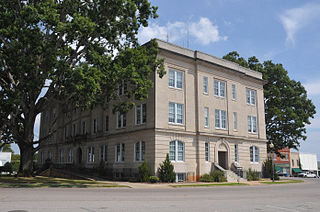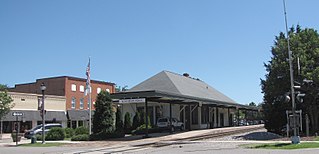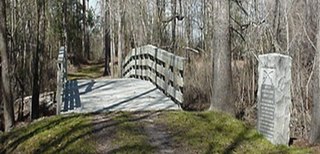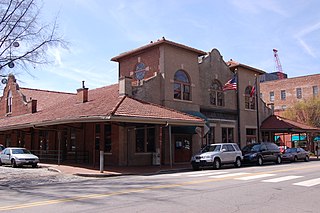
Carthage is the county seat of Moore County, North Carolina, United States. The population was 2,635 at the 2020 census. The city is named after Carthage.

Pinehurst, known formally as The Village of Pinehurst, is a village in Moore County, North Carolina, United States. As of the 2020 census, the village population was 17,581. Pinehurst refers to both the village, and the Pinehurst Resort, a Golf resort, which has hosted multiple United States Open Championships in the sport. A large portion of the central village, including the resort complexes, is a National Historic Landmark District, designated in 1996 for its landscape design by Frederick Law Olmsted and its significance in the history of golf in the United States. Pinehurst has been designated as the "Home of American Golf" by the United States Golf Association and by the State of North Carolina. The surrounding area is known for its strong equestrian community, including the former Stoneybrook Steeplechase, and the current Pinehurst Harness Track. Fox hunting is also a common sport in the area.

Southern Pines is a town in Moore County, North Carolina, United States. The population was 12,334 as of the 2010 United States Census.

Hanging Rock State Park is a 9,011-acre (3,647 ha) North Carolina state park in Stokes County, North Carolina in the United States. The park is 30 miles (48 km) north of Winston-Salem and is located approximately 2 miles (3.2 km) from Danbury in Stokes County.

Moores Creek National Battlefield is a battlefield managed by the U.S. National Park Service. The park commemorates the 1776 victory of a thousand patriots over about eight hundred loyalists at Moore's Creek. The battle dashed the hopes of British provincial governor Josiah Martin for regaining control of North Carolina for the Crown. The loyalist defeat simultaneously ended British plans for an invasionary force to land in Brunswick Town. The Second Continental Congress voted to declare independence from the British on July 4, 1776, shortly after the battle; which took place in the Wilmington area near Currie in Pender County in southeastern North Carolina. The national military park was established on June 2, 1926, and was redesignated as a national battlefield on September 8, 1980.

The Morris–Butler House is a Second Empire-style house built about 1864 in the Old Northside Historic District of Indianapolis, Indiana. Restored as a museum home by Indiana Landmarks between 1964 and 1969, the American Civil War-era residence was the non-profit organization's first preservation project. Restoration work retained some of its original architectural features, and the home was furnished in Victorian and Post-Victorian styles. Its use was changed to a venue for Indiana Landmarks programs, special events, and private rentals following a refurbishment in 2013. Regular daily tours of the property have been discontinued.

The Moore Square Historic District is a registered historic district located in downtown Raleigh, North Carolina. Listed on the National Register of Historic Places in 1983, the district is centered on Moore Square, one of two surviving four-acre parks from Raleigh's original 1792 plan. The park is named after Alfred Moore, a North Carolina judge who became an Associate Justice on the Supreme Court. Originally a residential neighborhood, Moore Square developed into a primary commercial hub in the city throughout the late 19th and early 20th centuries. The district includes East Hargett Street, once known as Raleigh's "Black Main Street", because it once contained the largest number of businesses owned by African-Americans in the city. City Market, Marbles Kids Museum/IMAX theatre, Pope House Museum, Artspace, and the Long View Center are located in the Moore Square district. Events that take place in Moore Square include the Raleigh Arts Festival, Artsplosure, Movies in the Park, the Street Painting Festival, and the Moore Square Farmer's Market The approximate district boundaries include Person, Morgan, Wilmington, and Davie Streets.

St. Philip's Church, Brunswick Town, is a ruined parish church in Brunswick County, North Carolina, United States. The Anglican church was erected in 1768 and destroyed in 1776. The ruins are located beside the Cape Fear River in the Brunswick Town Historic District, along with Fort Anderson, Russelborough, and the nearby Orton Plantation. During the American Revolutionary War, British forces attacked Brunswick Town in 1776 and burned the church. Before its demise, the church was considered one of the finest religious structures in North Carolina. On February 26, 1970, the historic site was added to the National Register of Historic Places.

Bird Island Light is a historic lighthouse at the entrance to Sippican Harbor in Marion, Massachusetts. Built in 1819, its tower is a well-preserved example of an early 19th-century masonry lighthouse. The tower and the island on which it stands were added to the National Register of Historic Places as Bird Island Light on September 28, 1987.

This list includes properties and districts listed on the National Register of Historic Places in Moore County, North Carolina. Click the "Map of all coordinates" link to the right to view an online map of all properties and districts with latitude and longitude coordinates in the table below.

The House in the Horseshoe, also known as the Alston House, is a historic house in Glendon, North Carolina in Moore County, and a historic site managed by the North Carolina Department of Natural and Cultural Resources' Historic Sites division. The home, built in 1772 by Philip Alston, was the site of a battle between loyalists under the command of David Fanning and patriot militiamen under Alston's command on either July 29 or August 5, 1781. The battle ended with Alston's surrender to Fanning, in which Alston's wife negotiated the terms with the loyalists.

The Isaac Roberts House is an historic house in Sandy Springs, Georgia.

The Moore Farm and Twitchell Mill Site is a historic property on Page Road in Dublin, New Hampshire. The 6.8-acre (2.8 ha) property includes an early 19th-century farmhouse, as well as the remnants of one of Dublin's earliest industrial sites. It lies just south of a bend in Page Road in southern Dublin, where Stanley Brook runs east-west along the south side of the road. In c. 1768 Samuel Twitchell, Dublin's second settler, built a sawmill that used Stanley Brook as its power source. This mill was the second established in what is now Dublin, after that of Eli Morse. It was used until the mid-19th century, and now only its foundations remain. The farmhouse of Samuel Moore was built in a glen on the south side of the brook c. 1812, and was a vernacular Cape style farmhouse. The farm was purchased in 1935 by William and Katherine Mitchell Jackson, and the house was moved about 100 yards (91 m) to the top of a rise where it has commanding views of Mount Monadnock. The house was restored and enlarged under the guidance of architects Bradley & Church and again renovated in 1951. The farm complex includes a barn that is contemporaneous to the house, and a caretaker's cottage that is a 1952 reconstruction of an earlier one destroyed by fire.
The John Covington Moore House is a historic house in rural Clay County, North Carolina. It is located on North Carolina Route 1307, about 4 miles (6.4 km) from the county seat, Hayesville. The 1+1⁄2-story log structure was built c. 1838 by John C. Moore, not long after the forced removal of the Cherokee from the area. The building is mounted on fieldstone piers, and has a porch extending across its front. There are shed-roofed rooms across the back of the house, and an exterior chimney at one end.

Eli Smallwood House is a historic home located at New Bern, Craven County, North Carolina. It was built about 1810, and is a 2+1⁄2-story, side-hall plan, Federal-style brick town house. It features hand carved ornaments on the main cornice, the porches, and the dormer. The brickwork is laid in Flemish bond. It was the home of Congressmen Charles R. Thomas (1827-1891) and his son Charles R. Thomas (1861–1931) from 1873 to 1925.

The Andrews-Moore House is a historic plantation house located near Bunn, Franklin County, North Carolina.

Eli Hoyle House is a historic plantation house located near Dallas, Gaston County, North Carolina. It was built about 1830–1833, and is a two-story, five-bay, Federal-style frame dwelling. It has a side-gable roof, exterior brick end chimneys, and sits on a stone foundation. It was built by Eli Hoyle (1801–1844), great-grandson of Pieter Hieyl who built the nearby Hoyle Historic Homestead.

James Bryant House is a historic home located near Harris Crossroads, Moore County, North Carolina. It is dated to about 1820, and is a two-story, three-bay, single-pile frame farmhouse. It rests on a fieldstone pier foundation, has a gable roof, shed porch, and rear shed rooms. The house has been restored. It was added to the National Register of Historic Places in 1982.

Lloyd–Howe House, also known as "Anchors Aweigh" and Clarendon Gardens and Howe House, is a historic home located near Pinehurst, Moore County, North Carolina, United States. It was built in 1929, and consists of a 1+1⁄2-story main block with a gable roof and one-story wings in an irregular configuration. Its style is a variation of the New England Cape Cod and contains 16 rooms over 5,778 square feet. It is sheathed in stained Georgia cypress weatherboards and has chimneys, flues and two terraces built of local bluish-brown Carthage stone.





















